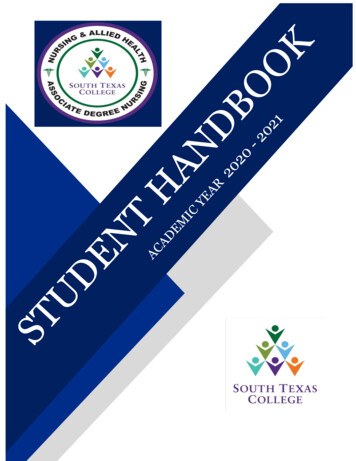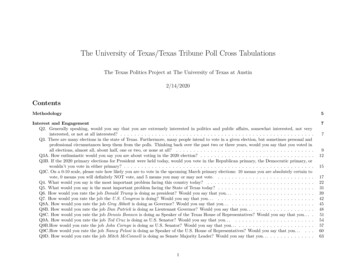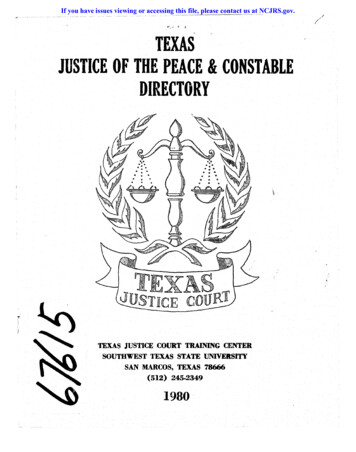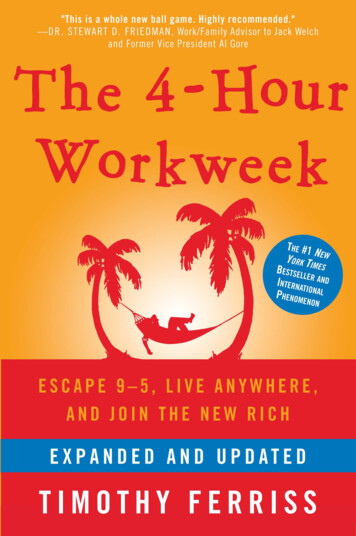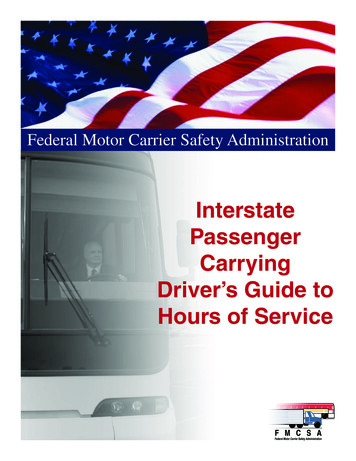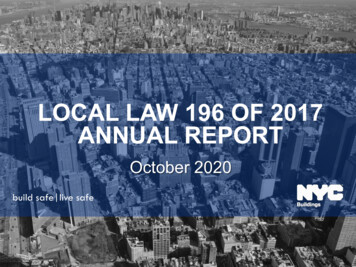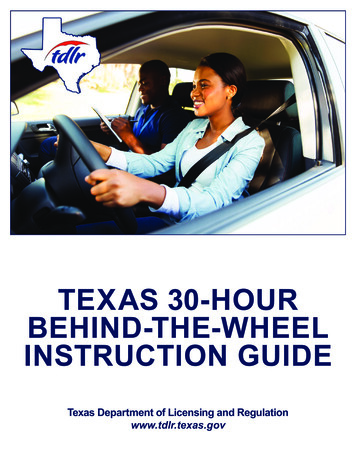
Transcription
TEXAS 30-HOURBEHIND-THE-WHEELINSTRUCTION GUIDETexas Department of Licensing and Regulationwww.tdlr.texas.gov
Table of ContentsPageYoung Drivers.3Texas Graduated Driver License Program.4Provisional License. 5Message from NHTSA.5Suggestions to Enhance Your Experience.7Suggestions Before Beginning Practice.7Control of Vehicle.8Commentary Driving.8During ALL Practice Hours: Your Teenager.8Sharing the Road Safely with Commercial Motor Vehicles and Large Trucks.9Sharing the Road Safely with Motorcycles.9Vehicle Safety Features and Maintenance. 10Driving in Adverse Conditions. 12Top Driving Errors. 13Getting Ready, Starting, Placing the Vehicle in Motion, and Stopping. 13Moving, Stopping, Steering, Knowing Where You Are. 14Backing. 15Turning, Lane Position, and Visual Skills. 15Searching Intended Path of Travel. 17Parking. 18Turnabouts. 20Multiple Lane Roadways. 21City Driving. 23Expressways/Freeways. 24Skid Recovery. 25Avoid Aggressive Drivers or Fatigued Drivers. 25Off-Roadway Recovery. 26Crossing Railroad Tracks. 27Braking Methods.27Other Resources.2830 Hour Behind-the-Wheel Practice Log.292
Young DriversDriving provides teenagers greater mobility. The knowledge, skills, judgment,behaviors, and understanding necessary to operate a vehicle safely take timeto develop. Safe drivers are not just born. In the driver education course youryoung driver acquired new and important knowledge and skills about basicvehicle operation such as turning, backing, and parking. Usually, these skillsare not difficult for young drivers to master. However, other skills, such asjudgment and understanding, require more practice.In 2015, motor vehicle crashes were the leading cause of deathfor young people ages 15 to 24 years old with half not wearinga safety belt at the time of the fatal crash.[ ]Texas Traffic Statisticsmay be located on theTexas Department ofTransportation website:http://www.txdot.gov/[ ]Driving is not aright; it is a privilegewith obligations,responsibilities, andconsequences.The U.S. Department of Transportation’s National Highway Traffic SafetyAdministration (NHTSA) states that “parental involvementcan mean the difference between life and death” during a teenager’s drivingexperience. NHTSA asks parents to be involved in their young driver’s drivinginstruction by supervising behind-the-wheel instruction and setting clear limitsconcerning wearing a safety belt, no texting or talking on a cell phone, nodrinking alcohol, or drug use, limiting the number of passengers, and restrictingnighttime driving.In an effort to reduce teen crashes and to save lives in Texas, the 81st Texas legislature enacted the Less TearsMore Years Act, which requires new drivers to have more driving experience prior to obtaining a license. Underthis act, young drivers must receive an additional 30 hours of behind-the-wheel instruction to be certified bya parent or guardian before a teenager may progress to Phase 2 of Texas’ Graduated Driver Licensing (GDL)program. The additional hours must include at least 10 hours that take place at nighttime.These 30 hours of behind-the-wheel instruction must be completed in the presence of an adult who meets therequirements of Section 521.222(d)(2), Transportation Code before the young driver is eligible for a provisionallicense. Only one (1) hour of behind-the-wheel instruction per day will count towards the 30 hours regardless ofthe number of hours the young driver actually drives in a day.[]Adult Qualifications: Section 521.222(d)(2), Transportation Code(d) A learner license entitles the holder to operate a type of motorvehicle on a highway while: (1) the license is in the holder’s possession;and (2) the holder is accompanied by a person occupying the seat by theoperator who: (A) holds a license that qualifies the operator to operatethat type of vehicle; (B) is 21 years of age or older; and (C) has at leastone year of driving experience.(g) A person who occupies the seat in a vehicle by a holder of a learnerlicense commits an offense if, while the holder is operating the vehicle,the person: (1) sleeps; (2) is intoxicated, as defined by Section 49.01,Penal Code; or (3) is engaged in an activity that prevents the personfrom observing and responding to the actions of the operator.Daytime means the period beginning one-half hour before sunrise andending one-half hour after sunset.Nighttime means the period beginning one-half hour after sunsetand ending one-half hour before sunrise.3Consider this document as a guide. It includes ideasthat should become an important part of your youngdriver’s instruction time. It describes basic skillsrequired in everyday driving and where to practicethese skills so that the needed additional behindthe-wheel instruction hours are conducted in a safe,supervised setting. As you and your teen becomecomfortable in simpler driving situations, look formore complex traffic environments.Be aware that young drivers have more difficultymaintaining attention and understanding how,when, what, who, and where to watch. Their abilityto judge distance also can be challenging.
Whether you live in a rural setting or a large community,allow your teenager to observe, explore, and drive inprogressively larger, more complex settings. For instance,allow your teenager to practice when weather limitsvisibility or there is reduced traction, or to drive on busierstreets.license (17 years of age for a Class A or B non-CDL),and has completed both the classroom and laboratory(driving) portions of driver education, they are eligible to“graduate” to Phase Two.Phase TwoPhase Two restricts the driving privileges of personsunder 18 years of age during the twelve-month periodfollowing the issuance of an original Class A, B, or Cdriver license (Provisional License). These persons maynot operate a motor vehicle with more than one passengerin the vehicle under the age of 21 who is not a familymember. They may not operate a motor vehicle betweenmidnight and 5:00 a.m. unless the operation of the vehicleis necessary for the operator to attend or participate inemployment or a school-related activity or because of amedical emergency.Your teenager’s thought process,decision-making, and problemsolving skills will developwith appropriate guidance,encouragement, and feedback.Reinforce good habits such aslonger following distances andavoiding distractions. Take the time to discuss thegoals, driver behaviors, and skills you practiced. Theknowledge, skills, and behaviors your teen learns nowcan become part of safe driving and reduced risk drivingpractices that last a lifetime. This also can be an enjoyable Under Phase Two,A teenager under the age ofa person under 17and special time with your teenage driver.years of age whoeighteen may not operate a motorholdsarestrictedTexas Graduated Drivervehicle while using a wirelessmotorcycleLicense Programlicense or mopedcommunication device, except inPhase Onelicense, duringcase of an emergency.Applicants under age 18 must hold a learner license orthe twelve-monthhardship license for a minimum of six months priorperiod followingto issuance of a provisional Class A, B, or C driverthe issuance of an original motorcycle license or mopedlicense. In addition, the minimum age of the person wholicense, may not operate a motorcycle or moped betweenmust accompany any learner license holder during themidnight and 5:00 a.m. unless the person is in sight of theoperation of the vehicle is 21 years of age. Except forperson’s parent or guardian or the operation of the vehiclehardship licenses, a minor is not eligible to graduate tois necessary for the operator to attend or participate inPhase Two (provisional license) for a Class A, B, or Cemployment or a school-related activity or because of adriver license until they have completed this phase andmedical emergency.met all other current licensing and age requirements.The license restriction will state, “TRC 545.424 appliesThe learner license must remain valid during theuntil MM/DD/YY” and will indicate the date in whichmandatory six-month period to meet this regulation.the second phase of the graduated driver license expiresIf a learner license is suspended/revoked during thisfor the person who holds that license. Upon completion ofperiod, upon the completion of the suspension period, the the twelve-month period, the above time and/or passengerremaining six-month period must be completed to meetrestrictions no longer apply. The licensee may wish tothe GDL Phase One requirement.apply for a duplicate license at a driver license officeto remove this restriction. A fee is required to obtain aOnce the applicant hasduplicate license. If not, this restriction will be removedUndertheGDLprogram,held a valid learnerat the time the applicant renews the license on their nextthere is no minimum timelicense or hardshipbirthday, provided the Phase Two 12-month time haslicense for a minimumlapsed.that a person must hold aof six months, hasrestricted motorcycle orreached the age ofmoped license before they can16 for a Class C4[[ ]apply for a Class M license.]
Provisional LicenseAll original licenses, other than a learner license, issued to persons under 18 years of age will be marked “Provisional.”The license will be vertical and will be dated to expire on the applicant’s 18th birthday. A fee is required to obtain thislicense. If the learner license or driver license is not due for renewal, a fee is required for a duplicate learner license orduplicate license.Documentation to Department of Public Safety (DPS) for Provisional License (Unrestricted driver license): Oncethe applicant has held a valid learner license or hardship license for a minimum of six months, has reached the age of16 for a Class C license (17 years of age for a Class A or B non-CDL), has completed both the classroom and laboratory(driving) portions of driver education and has completed the additional 30 hours of behind-the-wheel practice, they areeligible to apply for the provisional license. The teenager will be required to pass the Road Test at the DPS office beforelicensure. The items you will need to take to the DPS are as follows:1.2.3.4.5.Valid Learner licenseVerification of Enrollment and Attendance FormForm # DE-964 from school which provided the driver education course30 Hours Behind-the-Wheel Practice LogT he vehicle used for the Road Test must be able to pass an inspection where everything works properly, have a validinspection sticker, valid registration sticker, and current insurance6. Proof of Residency7. Money to pay for licenseMessage from NHTSA about Parent/Guardian’s Role in Teenage Drivingwww.nhtsa.gov1. Absolutely No Alcohol or Drugs - Teen drivers (ages15-20) are at far greater risk of death in crashes wherealcohol was present than the rest of us, even thoughthey cannot legally purchase or possess alcohol, whichincludes your teen and others he/she may ride with.It’s not just good parenting; it’s a matter of life and death.You need to talk to your teenager about traffic safety earlyand often – before they reach driving age. When yourteenager begins driving, we recommend that you set rulesand then clearly outline the consequences of breaking therules. Remind your teenager that driving is a privilege – aprivilege they will lose if they don’t drive by your rules.We know that getting through to your teen can be tough,but research tells us that teens listen to their parents, andthat you influence your teenager’s driving habits.These are staggering statistics - In 2016, almost one-thirdof teen drivers who were killed in crashes had a positiveBAC of .01 or higher at the time of the crash, even thoughit is illegal in all states for anyone under the age of 21 todrive with any trace of alcohol in their system. On averageover the last five years, one-fourth of the deaths in motorvehicle traffic crashes occurred when a teen driver had aBAC of .01 or higher.Set the StandardYou need to teach safe driving behavior from thebeginning. As the parent, you can start by modeling safedriving behavior anytime you drive your kids anywhere,even before they begin to drive.Talk to your teen about safety issues and the rules youare setting. Explain each one of your rules and theconsequences for breaking it. Write up a contract with yourteen driver to make sure they drive by the rules and driveas safely as possible. Include the most important issues.Here’s how: Spell out the rulesThe consequences are grim - If your teenager is luckyenough to survive a crash, they will have to face theconsequences of breaking the law. That includes a trip tojail, the loss of their driver’s license, and dozens of otherexpenses including attorney fees, court costs, and otherfines. They will also stand to lose academic eligibility,college acceptance, scholarship awards, and more.5
2. Seat belts: Always Buckle Up! Teens buckle upfar less frequently than adults do. The very first thingyou can do is set the right example for your teenagerby buckling yourself up every time you get in the car.[]When your teenis ready to drive,remind them thatfree, but not wearingwhether they aredriving across townor just around theit could cost a lifeneighborhood,wearing seat belts is the absolute best way to protectthemselves and their passengers from severe injury oreven death in the event of a crash.Wearing a seat belt isDespite efforts aimed at increasing belt use amongteens, observed seat belt use among teens (16 to 20years old) stood at 48.5 percent in 2016. Amongthose, 58 percent of all fatalities of 15 to 18-year-oldpassengers were unrestrained.In 2016 alone, 3,114 teenagers aged 16 to 20 years oldwere killed in motor vehicle crashes, and more thanhalf were not wearing their seat belts at the time of thecrash.We don’t know what the outcome would have beenfor those teens had they buckled up, but statistics tellus that in that same year, 72 percent of the passengervehicle occupants involved in fatal crashes who werewearing their seat belts survived the crash.3. Cell phone/texting: No talking or texting whiledriving. Talking on a cell phone while driving slowsdown the reaction time of even the most experienceddriver – making it the same as that of a 70-year-old.Can you imagine the impact it will have on yourteenager? And texting while driving is a serious riskfor teen drivers as well, forcing them to take their eyesand at least one hand off the steering wheel.[ ]Talk to your teendrivers about the risksof talking, texting, andother distractions, andset clear expectationsabout driving habits.Distracted driverscan kill or be killed.Driving distractionslike talking on a cellphone or textingwhile driving are aneven greater threatfor teens than for6others. In 2016, among drivers 15 and older involvedin fatal crashes, 15- to 17-year-olds had the highestpercentage of distracted drivers.4. Curfew: Have the car in the driveway by curfew.Talk to your teen driver about when you expect themto have the car back in the driveway. The reasonfor setting a “home-by” rule is to protect your kidsby keeping them from driving during the high-risknighttime hours. In 2016 male drivers 16-19 were 4times more likely to be in a fatal car crash from 6pmto midnight and female drivers of the same age were3 times more likely to be in a fatal crash than adultdrivers ages 30-59 during these driving hours. Ofall fatal car crashes for teens in 2016, 34% occurredbetween the hours of 6pm to midnight.[ ]5. Passengers: No moreMost of the deathsthan one at all times. Mostin crashes involvingteens are susceptible topeer pressure, which canyoung drivers arelead to risk-taking andthe young driversdistractions. In a surveythemselves and theircompleted by the Allstatepassengers.Foundation, almost half ofthe teens polled said they had been distracted by theirpassengers. And almost half also said they drive moresafely without their friends in the car.The more, the scarier - Research shows that the riskof a fatal crash goes up in direct relation to the numberof teenagers in the car.6. Graduated Drivers License (GDL): Follow thestate’s GDL law. Texas is one of the states includingthe District of Columbia that has adopted a GraduatedDriver’s License law. Make sure you and your teenagedriver know and understand the law, before they getbehind the wheel.Young, inexperienced drivers, particularly 16 to17-year-olds, die too often in fatal crashes, in largepart because of immaturity and inexperience. GDLlaws reduce these factors by reducing high-riskexposure for young drivers. Analysis shows GDLlaws have helped reduce crashes for this age groupanywhere between 20 and 40 percent. Keep yourteenager alive by insisting they follow the GDL rules.
7. Parental Responsibility: Set your house rules and consequences. Never forget thatmany young drivers (15 – 20 years old) are killed in crashes on our roadways everyyear. Talk to your young drivers about their driving before and after they have theirlicense. Set the rules for driving and explain the consequences of breaking the rules. Infact, your house rules can be tougher than the GDL laws, based on your assessment ofyour teen.[ ]Be supportive andpositive; this willpromote success.Be accountable, make them accountable – Write up an agreement that spells it out.Sign it and have your teen driver sign. Remind them that driving is a privilege that can be easily revoked.Review the agreement often.You can have an agreement with your teen without writing it down; however, writing it down makes itmore enforceable and meaningful. Keep an open dialog with your young driver and make your rules andconsequences crystal clear. Talk often and stick to your own rules and consequences.Suggestions to Enhance Your Experience Set aside time for practice.Be relaxed and keep your voice calm.Give clear feedback immediately and precisely.Plan your route before you start; rush hour traffic may not be the best time to practice.Know when to talk; a complicated maneuver may require lots of concentration. Reinforce the skills taught by the driver education course and have the Texas Driver Handbook available forreference.Make this time enjoyable and focus on the driving task, leaving other issues for later.Reinforce good decision-making that leads to reduced risk driving practices that will last a lifetime. Be a role model by wearing your safety belt and using correctWhile instructing, allow your youngdriving procedures such as making a complete stop at stop signs,driver to work on his/her safe drivingslowing to a stop at yellow lights, and obeying the speed limit,etc.decision-making skills. In the beginning, Be patient, calm, and alert at all times, making positive remarksyou may want to take them throughfrequently.every procedural step; however, as theSuggestions Before Beginning Practice[ ]sessions progress, you may want totalk less and less. I f possible, instruction should begin in a car with automaticWhen necessary, provide immediatetransmission so that your teenager can focus on mastering basicand clear-cut feedback. If incorrectvehicle control maneuvers.maneuvers are made, repeat the Select traffic environments that complement the lesson objectivesmaneuver taking the teenager step byand the teenager’s abilities.step through the process, and then allow Begin in a low-risk environment, which includes parking lots andpractice without assistance.progress to less traveled residential streets. Review previous lessons and explain what the next lesson will bebefore proceeding. Keep instructions simple and concise. First direct where to go, and then state the action to take(e.g., “At the next intersection, turn right.”) Check mirrors, and the space to all sides and ahead of the vehicle before giving directions. Remind the young driver not to panic when approached by an emergency vehicle and to focus on looking fora safe area to pull over. Discuss the rules for sharing the roadway with other users including pedestrians, bicycles, motorcycles schoolbuses, trains, trucks, animals, etc. and explain the risk each one presents. Encourage your teenager to change their route to avoid making a difficult left turn.7
Control of VehicleTo provide you with some control of the vehicle you may want to practice steering fromthe passenger seat. If the parking brake is located in the console between the driver andpassenger front seats, you may want to see if it will slow or stop the vehicle. To prepareyourself to regain speed control in the event your teenager panics and accelerates too much,practice shifting the transmission from drive to neutral from the passenger seat. You maywant to adjust the mirror on the passenger sun visor so you can use it as a rearview mirror.Also, you may want to use the right outside mirror.Commentary DrivingEncourage the use of commentary driving. This tool will allow you to check how your teenager is mentallyprocessing driving skills and evaluating the environment. Ask your teenager to “read the traffic picture aloud,”describing anything that may affect the roadway ahead or behind. For example, when your teenager changes speed,your teenager may say: “red light, check mirror, ease foot off accelerator, and brake.” You should frequently hear“check mirror and ease off accelerator!” Emphasize driving with a large anticipation zone by looking at least 15-20seconds ahead. Play the “what if game;” what if a car suddenly changes lanes, stops, turns, etc. Ask questions, suchas “Where were you looking,” or “What are the steps for this maneuver?”During ALL Practice Hours: Your Teenager[Texas laws requires children] Maintainsunder 8 years of age or lessan adequatethan 4 ft. 9 in. be infollowinga child passengerdistancerestraint systembetweenvehicles(infant seat, or booster seat).in frontand behind (recommended at least 4 seconds forteenagers). Maintains adequate side space. Communicates with other roadway users (signallights, hand signals, horn if necessary, lane placement,eye contact). Brakes smoothly, gradually slowing to a stop (tapsbrakes and checks rearview before slowing orstopping to warn other roadway users). Accelerates smoothly, steadily increasing to safespeed within posted limit and maintains appropriatespeed. Uses accelerator and brake pedals properly to managevehicle balance. Identifies and responds appropriately to all trafficsignals, signs, and roadway markings. Gives or accepts the right-of-way properly and safely. Possesses a valid learner license or driver license. Is mentally, emotionally, and physically preparedto drive. Do not drive fatigued, aggressively, ordistracted. Completes pre-drive checks. Uses and require passengers to use safety belts /teenager safety restraints. Performs proper starting tasks. Identifies and properly responds to alert and warninglights on the instrument panel. Obeys all traffic laws. Is watchful and attentive to the traffic scene bylooking ahead and to the sides and checking mirrorsto the sides and rear. Searches from the vehicle to at least 15 seconds aheadwhen driving in residential/city traffic and 20 to 30seconds ahead during freeway/expressway driving. Checks blind spots prior to changing lanes or makinga lateral maneuver. Understands that a green light means one must scanthe intersection before proceeding. Searches/scans to continuously identify hazards. Uses a space management system (safe space aroundthe vehicle) to establish and maintain proper vehicleoperating space and lane position. Performs speed and position changes in response totraffic flow and volume. Positions the vehicle to maintain an open line of sightand path of travel.[]Remember to review your vehicles owner’s8manual and the Texas Driver Handbook.
R ecognizes where the front, sides, corners, and rearof the vehicle are in relation to the roadway. Shares the road with and yields appropriately toother roadway users including identifying bicyclists,pedestrians, motorcycles, work zone and constructionworkers, trucks, and school buses, etc. Yields properly to emergency vehicles. Turns from and into proper lanes and properly usesturning lanes. Makes speed adjustments accordingly by performingspeed and position changes in response to traffic flowand traffic volume. Anticipates the actions of other roadway users. Is courteous to other roadway users who may betrying to pass or change lanes. Drives to conserve fuel and protects the environment while driving (such as do not litter). Uses headlights (including bright lights), windshieldwipers, defroster, and other vehicle devicesappropriately. Avoids other roadway users who are not mentally,emotionally, and physically prepared to driveincluding fatigued drivers, aggressive drivers, anddistracted drivers. Avoids driving in another vehicle’s blindspot,especially around and behind large trucks. Recognizes adverse conditions and appliescountermeasures to drive safely including increasingfollowing distance. Performs post-drive tasks properly, includingensuring all passengers and animals are safely out ofvehicle before locking.Sharing the Road Safely with Commercial Motor Vehicles and Large TrucksNOZONEProcedures1. Learn to read the language of trucks2. Weight (loaded or unloaded) will cause the truck to act differently3.
These 30 hours of behind-the-wheel instruction must be completed in the presence of an adult who meets the requirements of Section 521.222(d)(2), Transportation Code before the young driver is eligible for a provisional license. Only one (1) hour of behind-the-wheel instruction per day will count towards the 30 hours regardless of




